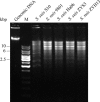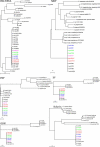Streptococcal toxic shock syndrome caused by Streptococcus suis serotype 2
- PMID: 16584289
- PMCID: PMC1434494
- DOI: 10.1371/journal.pmed.0030151
Streptococcal toxic shock syndrome caused by Streptococcus suis serotype 2
Erratum in
- PLoS Med. 2006 Aug;3(8):e377
Abstract
Background: Streptococcus suis serotype 2 (S. suis 2, SS2) is a major zoonotic pathogen that causes only sporadic cases of meningitis and sepsis in humans. Most if not all cases of Streptococcal toxic shock syndrome (STSS) that have been well-documented to date were associated with the non-SS2 group A streptococcus (GAS). However, a recent large-scale outbreak of SS2 in Sichuan Province, China, appeared to be caused by more invasive deep-tissue infection with STSS, characterized by acute high fever, vascular collapse, hypotension, shock, and multiple organ failure.
Methods and findings: We investigated this outbreak of SS2 infections in both human and pigs, which took place from July to August, 2005, through clinical observation and laboratory experiments. Clinical and pathological characterization of the human patients revealed the hallmarks of typical STSS, which to date had only been associated with GAS infection. Retrospectively, we found that this outbreak was very similar to an earlier outbreak in Jiangsu Province, China, in 1998. We isolated and analyzed 37 bacterial strains from human specimens and eight from pig specimens of the recent outbreak, as well as three human isolates and two pig isolates from the 1998 outbreak we had kept in our laboratory. The bacterial isolates were examined using light microscopy observation, pig infection experiments, multiplex-PCR assay, as well as restriction fragment length polymorphisms (RFLP) and multiple sequence alignment analyses. Multiple lines of evidence confirmed that highly virulent strains of SS2 were the causative agents of both outbreaks.
Conclusions: We report, to our knowledge for the first time, two outbreaks of STSS caused by SS2, a non-GAS streptococcus. The 2005 outbreak was associated with 38 deaths out of 204 documented human cases; the 1998 outbreak with 14 deaths out of 25 reported human cases. Most of the fatal cases were characterized by STSS; some of them by meningitis or severe septicemia. The molecular mechanisms underlying these human STSS outbreaks in human beings remain unclear and an objective for further study.
Conflict of interest statement
Figures






Comment in
-
Invasive disease and toxic shock due to zoonotic Streptococcus suis: an emerging infection in the East?PLoS Med. 2006 May;3(5):e187. doi: 10.1371/journal.pmed.0030187. Epub 2006 Apr 11. PLoS Med. 2006. PMID: 16594733 Free PMC article.
References
Publication types
MeSH terms
LinkOut - more resources
Full Text Sources
Other Literature Sources
Medical

